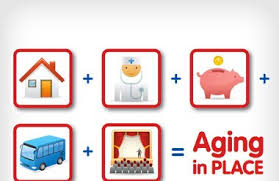26 of the 48 state Medicaid agencies studied could not report the number of “critical incidents” — such as abuse, neglect or exploitation.
You are here
Aging in place -- big talk, but do people really believe it?
 Who doesn’t want to live in their 'forever' home? After all, AARP has surveyed us for 2018 – staying there is apparently what 76% want, though only 59% expect that they will. But responders also know that you can’t always get what you want. Concerns included the need for transportation regardless of physical status, ability to stay active in the community, and availability of hospitals nearby (though that 911 call can fail to find us). And no, ride-sharing and self-driving cars are not viewed as panaceas. We know many of the reasons older adults will leave their homes – families and the draw of grandchildren pull them nearer; a spouse dies; the home itself is too costly to keep.
Who doesn’t want to live in their 'forever' home? After all, AARP has surveyed us for 2018 – staying there is apparently what 76% want, though only 59% expect that they will. But responders also know that you can’t always get what you want. Concerns included the need for transportation regardless of physical status, ability to stay active in the community, and availability of hospitals nearby (though that 911 call can fail to find us). And no, ride-sharing and self-driving cars are not viewed as panaceas. We know many of the reasons older adults will leave their homes – families and the draw of grandchildren pull them nearer; a spouse dies; the home itself is too costly to keep.
Why doesn’t senior living look like a more viable option? The senior living industry has been in various stages of denial for years – in good times, overbuilding and in bad times, failing to effectively expand services to those aging in their communities. Meanwhile, the average $3750/month costs of senior living communities are daunting to a population that may not have saved enough to support that choice. Seniors are aware of well-publicized life expectancy at 65 and 75. Consider a nationwide average $3750 cost (good luck finding an actual cost), that would amount to $675K over 15 years – for one person.
Will we stay -- or will we go? Assume baby boomers put our proverbial feet down – we just will not leave -- and nothing can make us. What should we have in (or do to) our homes that facilitates ‘aging in place?’ Can a home that is far away from family members really be modified and then outfitted to help us stay there and stay connected? Should it be? The AARP survey reveals hope but uncertainty – and a strong possibility of changing locations. Ironically, that new location may not be moving in with the kids. The growth in 55+ housing is steady – is that where baby boomers will want to go if they can?
Fixing to stay – what enables aging in place? Technology plays a useful but tangential role. Sensors are helpful, fall detection is helpful, video cameras and online connectivity – they are all helpful and may reduce social isolation and loneliness. But as the holidays approach, tickets are bought and everyone seemingly travels. Adult children look at the homes of their parents and think more about their own homes -- and wonder. Are these homes (ours, theirs) near public transportation, so limited in the suburbs? Are the homes single-story (desirable, possible), available in 76% of US housing units -- but in few suburban developments? How about night-time outdoor safety of walkways covered with ice or slippery with rain? What about walking a dog or tripping over the dog inside the house?

Comments
Love your work
Hi Laurie,
Great points and references!
I wanted to share a tiny bit about Irene and hope to connect with you soon. We set out to build a safer alternative to reverse mortgages. The foundation of the product comes from Italy and France - homeowners sell their remainders interest in their home and reserve a life estate. To deliver on the promise of peace of mind- we actively manage the property and cover taxes and insurance. Would love to hear your feedback and discuss sharing some of your work on our site.
Best,
Wilson
The worlds first virtual caregiver?
It sounds like a something out of a futuristic movie, and yet it’s real and it’s here today. A virtual caregiver, the next level of virtual assistants. She’s more than a table top speaker grill!
She’s got a face, a body, human gestures, dilating pupils, a compassionate smile, a swag set of scrubs, a dynamic personality, and she shows up at your door with a bag in her hand filled with state of the art health peripherals. Her name is Addison and her advancing communication skills integrate with wireless technology and medical plans of care, giving her the ability to be not only an endearing companion, but a virtual health and wellness partner.
Addison is designed to monitor, to collect vitals and responses to examination questions, to assess, and to identify indications of health stability, improvement or decline. Addison Care is a combination of conversational speech, animation technology, AI based visual sensing, augmented reality, wireless interactive assistive devices, a cloud based, proprietary enterprise management platform, and almost too many coordinated technologies to list. Addison is making her world debut alongside her Amazon partners at CES2019 in Las Vegas. You don't want to miss it. She will change the face of safe aging-in-place for decades to come!
Aging in Place
I'm wondering why the recent article doesn't mention the "village" concept as a viable option for those hoping the age in place. Having started in Boston, there are now over 400+ virtual villages nationwide using volunteers and a community to help seniors stay engaged and help with transportation and other tasks around the home.
https://www.ageinplacetech
https://www.ageinplacetech.com/search/site/Village